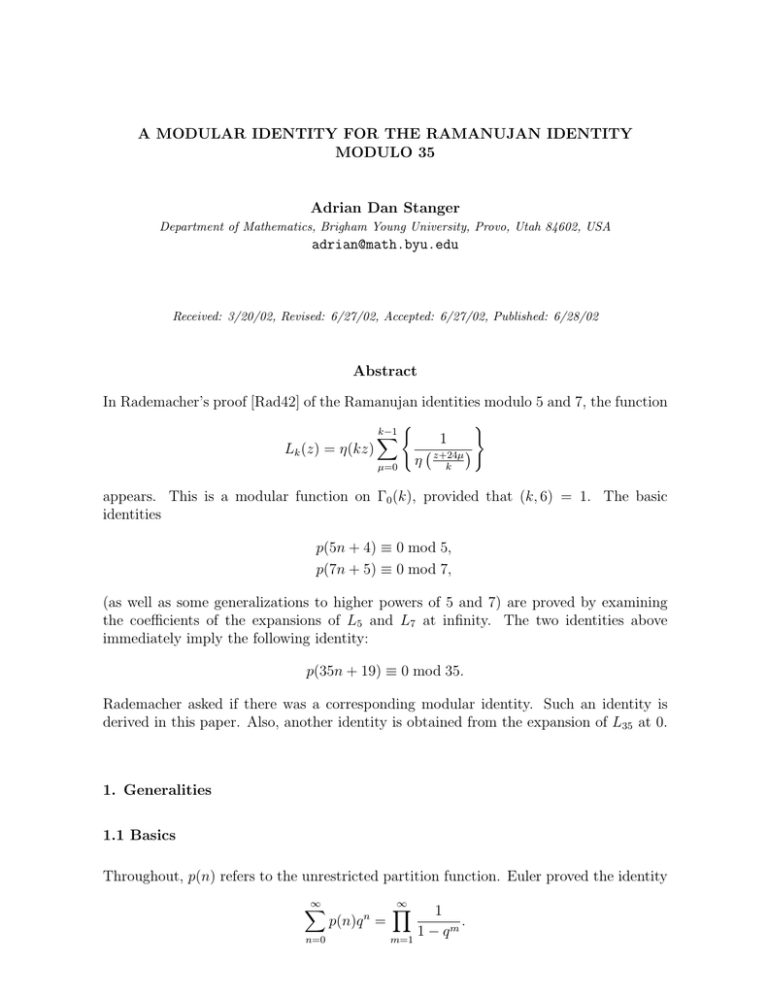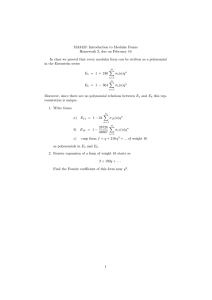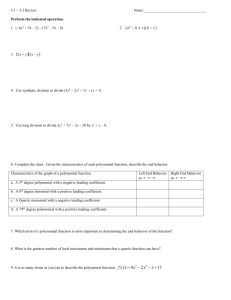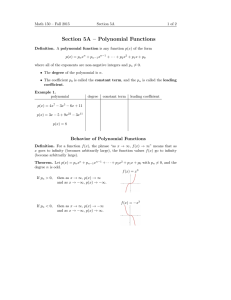A MODULAR IDENTITY FOR THE RAMANUJAN IDENTITY MODULO 35 Adrian Dan Stanger
advertisement

A MODULAR IDENTITY FOR THE RAMANUJAN IDENTITY
MODULO 35
Adrian Dan Stanger
Department of Mathematics, Brigham Young University, Provo, Utah 84602, USA
adrian@math.byu.edu
Received: 3/20/02, Revised: 6/27/02, Accepted: 6/27/02, Published: 6/28/02
Abstract
In Rademacher’s proof [Rad42] of the Ramanujan identities modulo 5 and 7, the function
)
(
k−1
X
1
¢
¡
Lk (z) = η(kz)
η z+24µ
k
µ=0
appears. This is a modular function on Γ0 (k), provided that (k, 6) = 1. The basic
identities
p(5n + 4) ≡ 0 mod 5,
p(7n + 5) ≡ 0 mod 7,
(as well as some generalizations to higher powers of 5 and 7) are proved by examining
the coefficients of the expansions of L5 and L7 at infinity. The two identities above
immediately imply the following identity:
p(35n + 19) ≡ 0 mod 35.
Rademacher asked if there was a corresponding modular identity. Such an identity is
derived in this paper. Also, another identity is obtained from the expansion of L35 at 0.
1. Generalities
1.1 Basics
Throughout, p(n) refers to the unrestricted partition function. Euler proved the identity
∞
X
n=0
n
p(n)q =
∞
Y
1
.
1 − qm
m=1
INTEGERS: ELECTRONIC JOURNAL OF COMBINATORIAL NUMBER THEORY 1 (2002), #A09
2
We will see that this ties the partition function intimately to certain types of modular
functions (and forms). Let Γ(1) = PSL2 (Z), which is the special linear group modulo its
center (±I). Γ(1) is generated by the two transformations
µ
¶
µ
¶
0 1
1 1
S=
, T =
.
−1 0
0 1
We’ll have need also for the product T ST, which we will call W . Then in Γ(1), we have:
µ
¶
1 0
W =
.
1 1
Γ(1) acts faithfully on the upper half plane H = {z ∈ C : =(z) > 0} via linear fractional
transformation. Throughout, we will identify a linear fractional transformation and its
matrix.
We let q = e2πiz throughout. In what follows, Dedekind’s function η(z) will be used,
πiz Q
2πinz
so we remind the reader of some known facts. Recall η(z) = e 12 ∞
), and
n=1 (1 − e
note that η(z) is periodic of period 24. It is pole-free and zero-free throughout H. It is
a modular form of weight one half, and has a multiplier which is a 24th root of unity in
its transformation equation. The root of unity ε(a, b, c, d) is determined by the following
formulas (provided c 6= 0):
½
µ
ε(a, b, c, d) = exp πi
¶¾
a+d
+ s(−d, c)
,
12c
µ
· ¸
¶
k−1
X
r hr
hr
1
s(h, k) =
−
−
,
k k
k
2
r=1
(1)
where [ ] is the greatest integer function. For properties of the Dedekind s(h, k) sum see
[RW41, RG72]. We will
µ often
¶ write just ε in place of the more cumbersome ε(a, b, c, d).
a b
Thus, for any A =
∈ Γ(1), η(Az) = ε(cz + d)1/2 η(z). There is a relationship
c d
between η and p. Namely,
1
∞
X
q 24
n
.
p(n)q =
η(z)
n=0
Also, Lk has q-expansion given by:
Lk (z) = kq
k
1+[ 24
]
∞
Y
m=1
(1 − q
km
)
∞
X
p(kn + ∆)q n ,
n=0
∆ least positive solution of 24n ≡ 1 mod k. (2)
It is clear that Lk has all its poles located at the cusps of Γ0 (k). Note that when k =
35 (resp. 5, 7), ∆ = 19 (resp. 4, 5). This explains the form for the identities listed
earlier. That Lk (z) is a modular function on Γ0 (k) may be seen as follows. One can show
INTEGERS: ELECTRONIC JOURNAL OF COMBINATORIAL NUMBER THEORY 1 (2002), #A09
3
η(kz)
η ( kz )
is a modular function on Γ00 (k) using known facts about Dedekind sums (see
µ
¶
1 24µ
particularly Theorems 17 and 18 of [RW41]). The matrices
, (0 ≤ µ ≤ k − 1)
0 1
form a set of coset representatives for Γ00 (k) in Γ0 (k). Therefore, when we sum over this
set of coset representatives to obtain Lk (z), we obtain a modular function on Γ0 (k).
S
Let ω ∈ Q {i∞} be a cusp for Γ0 (k). We will let Hω be the set of modular functions
on Γ0 (k) having poles only at ω. It is with this space of functions that we will work. In
particular we will consider functions in Hω , where ω = 0 or i∞.
that
We mention also the Fricke involution Sk (z) = −1
. Let F denote the set of modular
kz
functions on Γ0 (k), and f ∈ F. Sk (z) is an operator from F to itself. Moreover, it
interchanges the polar orders of f at i∞ and 0 in the appropriate uniformizing variables
(i.e, the expansion of f (Sk (z)) at i∞ has the same order in the variable q, as the expansion
1
of f (z) at zero has in the variable q k ). For the rest of section 1, let k = pQ, where p
and Q are two distinct primes strictly greater than 3. Then Sk (z) interchanges the polar
orders of f at the cusps p1 and Q1 as well.
1.2 Evaluation at 0
Pursuant to our task, we need to determine the order of Lk at each of the cusps. We
determine the expansion about 0. To do so we subject Lk to the transformation Sk and
then compute the expansion as usual.
·µ
¶ ¸X
¶ ¸¾−1
k−1 ½ ·µ
0 −1
24µk −1
Lk (Sk z) = η
z
.
η
z
1 0
k2
0
µ=0
We need to factor the inner matrix as the product of a unimodular matrix and an upper
triangular matrix. Upon factoring and applying the transformation identities we obtain:
k−1
X
1
1
¡
Lk (Sk z) = √ η (z)
24µ
k
ε( δ , b, δ , d) δ 1/2 η δ 2 z +
k
µ=0
where δ = (µ, k), and the matrix inside factors as:
µ
¶µ
¶
24µ/δ b
δk y
,
k/δ d
0 k/δ
for some integers b, d and y such that
24µ
bk
y+
= −1,
δ
δ
δy
k
¢,
INTEGERS: ELECTRONIC JOURNAL OF COMBINATORIAL NUMBER THEORY 1 (2002), #A09
4
24µ
bk
d−
= 1.
δ
δ
Together, the two equations yield that y = −d (in the case µ = 0 this is clear). Thus we
obtain the following expression:
(
)
∞
k−1
∞ ³
´ −1
X
Y
πiyδ
δ 2 −1
1
1 Y
2
Lk (Sk z) = √
ε δ 2 e 12k q 24
1 − e2πiδyn q δ n
(1 − q m )
.
(3)
k m=1
µ=0
n=1
Now, since µ = 0 is the only term of the sum in which δ = k, and this yields the largest
negative power of q, we see that ord0 (Lk ) ≥ (1 − k 2 )/24. We will return to equation 3
later.
1.3 Evaluation at all other cusps
Since k is square-free, all the other cusps of Γ0 (k) occur at the points {1/l| 1 < l < k, l|k },
in other words, at p1 and Q1 . To determine the order of Lk at 1/l, we subject it to the
transformation W −l and then evaluate. Thus, we obtain
¡
−l
¢
Lk W z = η
¡
·µ
¶µ
k/l 1 − k/l
l
=η
−1
1
0
½ µ −l
¶¾−1
W z + 24µ
η
kW z
k
µ=0
¶ ¸X
¶ ¸¾−1
k−1 ½ ·µ
1 − 24lµ 24µ
k/l − 1
η
z
.
z
k/l
−kl
k
−l
k−1
¢X
µ=0
Now, let δ = (1 − 24µl, k/l). Then the matrix inside factors as
µ
¶µ
¶
(1 − 24µl)/δ b
δ y
,
(−kl)/δ
d
0 k/δ
for integers b, d and y such that
1 − 24µl
bk
d+
l = 1,
δ
δ
1 − 24µl
bk
y+
= 24µ,
δ
δ
−kl
kd
y+
= k.
δ
δ
The final equation above yields −ly + d = δ. Using this fact we see that
−l
− k+l
πi
12l
Lk (W (z)) = e
p
l/k η
µ
l2 z − l + k
k
¶X
k−1 ½
µ
εδ
µ=0
1/2
η
δ 2 z + δy
k
¶¾−1
INTEGERS: ELECTRONIC JOURNAL OF COMBINATORIAL NUMBER THEORY 1 (2002), #A09
− k+l
πi
12l
=e
k−1
X
p
l/k
´
l2
1 − ρ(k−l)n q k n ×
m=1
(
εδ
∞ ³
Y
1/2
ρ
dy+k−l
24
µ=0
q
δ 2 −l2
∞ ³
Y
24k
5
1−ρ
δyn
q
δ2
n
k
´
)−1
³
,
ρ=e
2πi
k
´
.
n=1
2. Specialization to k = 35
2.1 Obtaining an explicit polynomial identity at i∞
Now, we take k = 35 for the remainder of this paper. We see from the results above
that L35 (z) has a zero of order 2 at i∞ in the variable q, a pole of order 51 at 0 in the
1
1
variable q 35 , is holomorphic at 1/5 in q 7 , and has a zero of order at least 1 at 1/7 in
1
the variable q 5 . We refer the reader to [New57] for an explicit construction of the basis
functions with which we will work, and for an account of the functions A9 and B8 (as
well as other similar functions used in deriving the basis of functions at infinity). In
summary, the basis functions B4 , B5 , B6 , and B7 all have poles only at i∞ in the same
order as the value of their respective subscript. Similarly, A9 and B8 have poles of order
9 and 8, respectively, at i∞, and A9 has zeroes of orders 5, 1, and 3 at 0, 1/5 and 1/7
respectively, while B8 has zeros of orders 6 and 2 at 0 and 1/7 respectively.
Suffice it to say that G(z) = A9 (z)B88 (z)L35 (z) is pole-free in H and has order −71
at i∞, 2 at 0, 0 (or possibly greater) at 1/5, and 20 at 1/7. So we have:
Theorem 1. G(z) ∈ C[B4 , B5 , B6 , B7 ].
The proof follows from the work in the previous section and the fact that the Bi do
form a polynomial basis for the set of modular functions in Hi∞ .
Since the order at i∞ is known, the polynomial is determined, using Mathematica to
calculate the coefficients. Among the possible ways of choosing an appropriate form, it
was determined to use B7 to keep the total degree (as a polynomial in the Bi ) as small
as possible. For instance the terms matching q −65 , q −64 , q −63 are B78 B5 B4 , B78 B42 , B79
−8
respectively. Call the polynomial that we obtain P∞ . Then L35 (z) = A−1
9 B8 P∞ .
Theorem 2. Let ci be the coefficient on the term of P∞ corresponding to q i . Then the
polynomial P∞ is determined by the coefficients in the appendix in table 1, where ci is
the given ith coefficient multiplied by 1225 (= 352 ).
Corollary 3. p(35n + 19) ≡ 0 mod 35.
Remark 1. This identity also shows how the genus dramatically affects a polynomial
identity associated with such an identity for the partition function. For the cases k = 5
INTEGERS: ELECTRONIC JOURNAL OF COMBINATORIAL NUMBER THEORY 1 (2002), #A09
6
and k = 7, where the genus is 0, Rademacher obtains a linear polynomial and a quadratic
polynomial, respectively, in the respective basis function. Here, the genus is 3 and a
polynomial of degree 11 in the four basis functions is obtained. In a similar manner,
modular identities for the congruences for 55 and 77 may surely be constructed. It is
expected that more basis functions and a higher-degree polynomial will be necessary.
2.2 An Identity at 0
We return to equation 3. Recalling the connection with the partition function p, and
separating into cases depending on δ, we have :
34
∞
∞
X q 1−δ
X
X
Y
24
(24n−1)δyπi
−1 − 12
δ2 n
12k
√
Lk (Sk (z)) =
ε δ
e
p(n)q
(1 − q m ).
k µ=0
n=0
m=1
δ|35
2
When we group the outer sum into terms by δ, we obtain Gauss sums for the JacobiLegendre symbol of the appropriate modulus. We have the following terms:
∞
∞
X
1 Y
m
δ = 35 :
(1 − q )
p(n)q 1225n ,
35q 51 m=1
n=0
µ
∞
∞
X n − 4¶
1 Y
m
δ=7:
− 2
p(n)q 49n ,
(1 − q )
7q m=1
5
n=0
µ
∞
∞
X n − 5¶
1 Y
m
δ=5:
−
(1 − q )
p(n)q 25n ,
5q m=1
7
n=0
¶
∞
∞ µ
Y
X
n − 19
m
δ=1:
p(n)q n ,
(1 − q )
35
m=1
n=0
where (-) indicates the Jacobi-Legendre symbol.
Now, L35 (S35 z) has order −51 (resp. 2, 1, −1) at i∞ (resp. 0, 1/5, 1/7). For the last
two points we really only know that the order at each of these points is greater than or
equal to the given value. Nevertheless, this is sufficient to determine that the function
h(z) = B8 (z)L35 (S35 z) has its only pole at i∞, and the order of the pole there is 59.
Thus, h(z) ∈ C[B4 , B5 , B6 , B7 ].
To clear fractions, multiply by 35 and then note 35L35 (S35 z) = B8−1 P0 , where P0 is a
polynomial to be determined in the four basis functions. So
q
−51
− 5q
−2
− 7q
−1
+ 35 + ... =
P0 B8−1
∞
X
p(n)q n .
n=0
This yields the following:
Theorem 4. 35L35 (S35 z) is a polynomial in the basis functions B4 , B5 , B6 , B7 , with integral coefficients given in table 2 of the appendix.
INTEGERS: ELECTRONIC JOURNAL OF COMBINATORIAL NUMBER THEORY 1 (2002), #A09
7
Corollary 5.
∞ ½
X
µ
¶
n−4
p(n)q
−5
p(n)q 49(n+1)
5
¾
µ n=0 ¶
µ
¶
n−5
n − 19
25(n+2)
n+51
−7
+ 35
p(n)q
p(n)q
7
35
∞
X
51
−1
= q P0 B8
p(n)q n .
1225n
n=0
I would like to thank my doctoral advisor, Morris Newman, who suggested this problem to me, and Bruce Berndt and the referee for their helpful comments.
3. Appendix: tables
Table 1: Coefficients for P∞
i
-69
-68
-67
-66
-65
-64
-63
-62
-61
-60
-59
-58
-57
-56
-55
-54
-53
-52
-51
-50
-49
-48
-47
-46
coefficient
14
10487
1050000
37305717
689742738
6710739396
66723377634
306529775888
944992220254
8032835276603
41786228768706
163674979606784
201541582793635
1192164476376773
2133885512377322
-224422822302317
9311212319487067
53104246090438488
174875061214811942
59790513579741686
418363890733605649
1123804424169272601
-1849756259047888932
-3961615256484350591
i
-33
-34
-33
-32
-31
-30
-29
-28
-27
-26
-25
-24
-23
-22
-21
-20
-19
-18
-17
-16
-15
-14
-13
-12
coefficient
-10569223238228513913405
-29246449555394872646896
-30752043774402282243297
-10500761656485195685244
-63994584518030323125
747396610368371686739
41866861538739825786329
-154825275874629072148111
-330675045299039974754087
-330675045299039974754087
-195434688782712582767044
106519373950966952221
-4489388038461810926594
93815803283069768407781
-868861692593019875600320
-780240652273282530768564
-903341606561540466301311
-575916410654649291605538
-72387387334271714225
5279005749531844180716
-329709784193546752041430
-754715959977583205060136
2673409023878484316383343
3038512747510492176975342
continued on next page
INTEGERS: ELECTRONIC JOURNAL OF COMBINATORIAL NUMBER THEORY 1 (2002), #A09
Table 1: continued
i
coefficient
i
coefficient
-45
1372328949965814202 -11 1778681601887609961535840
-44
19742808525931603996 -10
16760790778989818745
-43
2177933533113105157 -9
-1894749705906830722098
-42
23516820211582241283 -8
189938163107999640927156
-41 123390318981474451231 -7
4789820626890790384933368
-40 -271841378745461882544 -6 -1532454919226226734377599
-39 -777621797568622505476 -5 -1735248899286586237586336
-38 -673143178730309518022 -4
-997109474512591275870705
-37 268511875093390021788 -3
0
-36
10323721732692166606 -2
0
-35 334287613007887666292 -1
0
-34 3963341600197861903691 0 -3000539263195134467759624
Table 2: Coefficients for P0
i
coefficient
i
coefficient
-59
1 -29
101856
-58
-5 -28 -1088550
-57
13 -27
-779536
-56
-24 -26
-868518
-55
-124 -25
-638720
-54
-167 -24
183785
-53
-100 -23
310027
-52
186 -22 -1009582
-51
82 -21
-5533
-50
-784 -20
8917982
-49
1899 -19 10010374
-48
7839 -18
6789719
-47
9103 -17
-21976
-46
5400 -16
113545
-45
-531 -15
35220
-44
2196 -14 21729982
-43
-786 -13
-703140
-42
13705 -12
-920456
-41
-1006 -11
-843856
-40
-4690 -10
-236844
-39
1882 -9
-376949
-38
-6611 -8
1365595
-37
-16039 -7
-4046123
-36
44380 -6 -12312578
-35
-84846 -5 -13942378
continued on next page
8
INTEGERS: ELECTRONIC JOURNAL OF COMBINATORIAL NUMBER THEORY 1 (2002), #A09
9
Table 2: continued
i
coefficient
-34
-393717
-33
-427964
-32
-282747
-31
-17208
-30
-53917
i
-4
-3
-2
-1
0
coefficient
-9425016
0
0
0
-30151150
References
[Apo95] T. M. Apostol. Introduction to Analytic Number Theory. Springer-Verlag, 1995.
[Apo97] T. M. Apostol. Modular Functions and Dirichlet Series in Number Theory,
volume 41 of Graduate Texts in Mathematics. Springer-Verlag, second edition,
1997.
[New57] M. Newman. Construction and application of a class of modular functions.
Proceedings of the London Mathematical Society, VII(27):334–350, July 1957.
[Rad42] H. Rademacher. The Ramanujan identities under modular substitutions. Trans.
American Math. Soc., 51(3):609–636, May 1942.
[RG72] H. Rademacher and E. Grosswald. Dedekind Sums. MAA, 1972.
[RW41] H. Rademacher and A. Whiteman. Theorems on Dedekind sums. American
Journal of Mathematics, 63:377–407, 1941.






